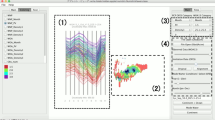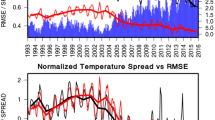Abstract
The distribution of water masses has become one of the most important topics in recent oceanic research. Water masses flow dynamically and have interannual variability, and hence the distribution can change dramatically even over short time periods and may differ from year to year. In this paper, we use a high-resolution ocean dataset, which contains multiple ocean variables, to visualize the details of the water mass. Because water mass can be defined by multiple ocean variables (e.g., temperature and salinity), we develop a multi-variate visualization system, which allows us to extract the time-varying distributions of water masses from multiple variables. The visualization is then adjusted by multiple ocean specialists because directly applying the existing definition to extract the water mass would result in incorrect rendering results. This leads to another problem that different ocean specialists may have different perspectives on the distribution of water masses, so that the adjustments would also be different. To solve this problem, an ensemble average process is performed for the adjusted rendering results from multiple ocean specialists. To increase the authenticity, we also add a voting scheme to the system, so that a majority rule can be applied to the ensemble-averaging result. As the application of the proposed voting-based ensemble-averaging visualization system, we first show the interannual variability of the significant water mass and then visualize the dynamic behavior for the period of interest in different years. We also highlight a mixing phenomenon that has a strong influence on the distribution of the water mass. As a result, we can obtain a clear and accurate visualization of the water mass distribution.
Graphical Abstract















Similar content being viewed by others
References
Ana LR, Isoda Y, Uehara K, Aiki T (2007) Seasonal variations of water system distribution and flow patterns in the southern sea area of Hokkaido Japan. J Oceanogr 63:573–588
Hurlburt HE, Wallcraft AJ, Schmitz WJ Jr, Hogan PJ, Metzger EJ (1996) Dynamics of the Kuroshio/Oyashio current system using eddy-resolving models of the North Pacific Ocean. J Geophys Res 101(C1):941–976
Ishikawa Y, Awaji T, Toyoda T, In T, Nishina K, Nakayama T, Shima S, Masuda S (2009) High-resolution synthetic monitoring by a 4-dimensional variational data assimilation system in the northwestern North Pacific. J Mar Syst 78:237–248
Meehl GA, Teng H, Branstator G (2006) Future changes of El Niño in two global coupled climate models. Clim Dyn 26(6):549
Mitnik LM, Lobanov VB (2011) Investigation of Oyashio–Kuroshio frontal zone using alos PALSAR images and ancillary information. In: Proceeding of: 2011 IEEE international geoscience and remote sensing symposium
Mizuno K (1988) Short term variability in the Tsugaru warm current and its effect on fisheries. GeoJournal 16(1):65–71
Nakada S, Ishikawa Y, Awaji T, In T, Shima S, Nakayama T, Isada T, Saitoh S (2012) Modeling runoff into a region of freshwater influence for improved ocean prediction: an application in Funka Bay. Hydrol Res Lett 6:47–52
Onishi M, Ohtani K (1997) Volume transport of the Tsushima warm current, west of Tsugaru Strait bifurcation area. J Oceanogr 53:27–34
Phadke MN, Pinto L, Alabi O, Harter J, Taylor RM, Wu X, Petersen H, Bass SA, Healey CG (2012) Exploring ensemble visualization, visualization and data analytics (San Francisco, California, 2012), 8294(paper 0B):1–12
Potter K, Wilson A, Bremer PT, Williams D, Doutriaux C, Pascucci V, Johhson CR (2009) Ensemble-vis: a framework for the statistical visualization of ensemble data, IEEE workshop on knowledge discovery from climate data: prediction, extremes. pp 233–240
Sabella P (1988) A rendering algorithm for visualizing 3D scalar fields. Comput Graph 22(4):51–58
Sakurai Y (2007) An overview of the Oyashio ecosystem. Deep Sea Res Part II 54(23):2526–2542
Sanyal J, Zhang S, Dyer J, Mercer A, Amburn P, Moorhead RJ (2010) Noodles: a tool for visualization of numerical weather model ensemble uncertainty. IEEE Trans Visual Comput Gr 16(6):1421–1430
Séférian R, Iudicone D, Bopp L, Roy T, Madec G (2012) Water mass analysis of effect of climate change on air-sea CO2 fluxes: the southern ocean. J Clim 25:3894–3908
Sisnerosa R, Huangb J, Ostrouchovc G, Ahernc S, Semeraroa BD (2013) Contrasting climate ensembles: a model-based visualization approach for analyzing extreme events. Procedia Comput Sci 18:2347–2356
Smith KM, Banks DC, Druckman N, Beason K, Hussaini MY (2006) Clustered ensemble averaging: a technique for visualizing qualitative features of stochastic simulations. J Comput Theor Nanosci 3(5):752–760
Yang GJ, Wu KQ (2007) A computational topology approach to automatic partition and visualization of oceanic water masses. IEEE CAD/Graphics. pp 493–496
Yasuda I, Watanabe Y (1994) On the relationship between the Oyashio front and saury fishing grounds in the north-western Pacific: a forecasting method for fishing ground locations. Fish Oceanogr 3(3):172–181
Zhao K, Nakada S, Sakamoto N, Koyamada K, Bajaj C, Ishikawa Y, Awaji T, In T, Saitoh SI (2013) A visualization of the dynamic behaviors of the mixture of water mass using ocean simulation data for northwestern Pacific near Japan. Int J Model Simul Sci Comput 4(supp. 01)
Zhao K, Sakamoto N, Koyamada K (2012) A temporal coherence based framework for visualizing time-varying unstructured volume with PBVR. In: Proceedings of Asia simulation conference (AsiaSim2012), pp 163–174 (Part 1)
Zhao K, Sakamoto N, Koyamada K (2012) A volume compression scheme based on block division with fast cubic B-spline evaluation. In: Proceedings of Asia simulation conference (AsiaSim2012), pp 373–388 (Part 3)
Acknowledgments
This work was supported by Japan Society for the Promotion of Science (JSPS) KAKENHI Grants-in-Aid for JSPS Fellows (Grant No. 26·837) and was partially supported by the Ministry of Education, Culture, Sports, Science and Technology (MEXT), Grat-in-Aid for Data Integration and Analysis System (DIAS), Grant-in-Aid for Research Programs on Climate Change Adaptation (RECCA), and by the Japan Science and Technology Agency (JST), A-STEP project (“The research and development of fusion visualization technology”, AS2415031H).
Author information
Authors and Affiliations
Corresponding author
Rights and permissions
About this article
Cite this article
Zhao, K., Nakada, S., Sakamoto, N. et al. Voting-based ensemble-averaging visualization for water mass distribution. J Vis 18, 719–731 (2015). https://doi.org/10.1007/s12650-014-0258-6
Received:
Revised:
Accepted:
Published:
Issue Date:
DOI: https://doi.org/10.1007/s12650-014-0258-6




